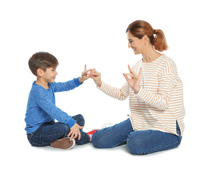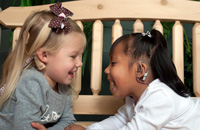The information on this page was originally developed by a team that created a website for families focused on "raising deaf kids” (See
About Us). Edits and updates may have been made.
Read this page for tips about communicating with your child who is deaf or
hard of hearing.
Maybe you use sign language or maybe you talk with your child or both.
In all these approaches, there are things you can do to help your child communicate with you and with other people.
Help your child communicate with your family every day.
- Include your child in all family conversations.

- Use facial expressions and gestures to help get your ideas across.
- Have "conversations" with your child. Encourage her to talk to you.
- Try to get her to answer questions with more than a "yes" or "no."
- Help your child learn about taking turns in conversations
- Encourage the rest of your family to be patient if you need to repeat or translate what they said.
- Take the time to listen to your child.
- Try to understand what she's saying.
- Ask other family members to do the same.
Help your child learn to express feelings.
Help your child use words to tell stories.
- Make picture books with your child about what you do during the day
- Fill the picture book with pictures you take with your camera.
- Use pictures you cut out from magazines.
- Fill the book with your child's drawings.
- Later, use the picture books to talk about what you did.
Read with your child.
Communicate With People Who Are Deaf or Hard of Hearing
Do you have a friend, classmate or co-worker who is deaf? Maybe he uses sign language or maybe he speaks. Either way, there are things you can do that will help you communicate.
How to communicate with a person who is deaf or hard of hearing
Communicating with a person who is DHH sometimes takes longer than talking with a hearing person. It can be rewarding. Follow these tips the next time you meet someone who is deaf or hard of hearing.
Be prepared.
- Ask the person what would be the best way to communicate.
- Have paper and pencil ready. You may want to write down words that are hard to understand.
Find a quiet, well-lit room to talk in.
- Good lighting helps both of you see each other's faces.
- Background noise makes it harder to hear if you have a hearing aid.
Be patient.
- Try not to rush. Rushing can make it hard for the other person to hear you or read your lips.
- Don't pretend to understand if you don't. Ask the person to repeat what he said.
- Nodding doesn't always mean a person understood what you said. Ask him, "Do you understand?" Or ask, "Do you want me to say that again?"
- If the person doesn't understand you, repeat what you said, You may want to use shorter, simpler sentences or re-word what you said in a new way.
Talk normally, and keep your mouth clear.
- Talk normally and naturally. There is no need to shout. Shouting changes the way your face looks. It can make things harder to understand.
- Don't overdo your lip movements. Talking a little slower and clearly helps the most.
- Don't put anything in your mouth while talking.
- Don't cover your mouth or turn your head away while talking.
Make sure you can see the other person's face clearly. Make sure he can see yours, too.
- Wait until the person can see you before talking
- Stand or sit about 3 to 6 feet from the person.
- For groups, have everyone sit in a circle so everybody's face can be seen.
- Watch facial expressions.
- Look right at the person when you are talking.
Learn sign language.
- Try to learn from someone who uses American Sign Language (ASL) as a first language.
- Take a sign language class. Classes may be offered at
- the local school for the deaf
- adult education programs
- other community programs
- local colleges
- Make a friend. Deaf adults are often eager to meet hearing people who want to make friends.
- Get a sign language video. There are many resources online.